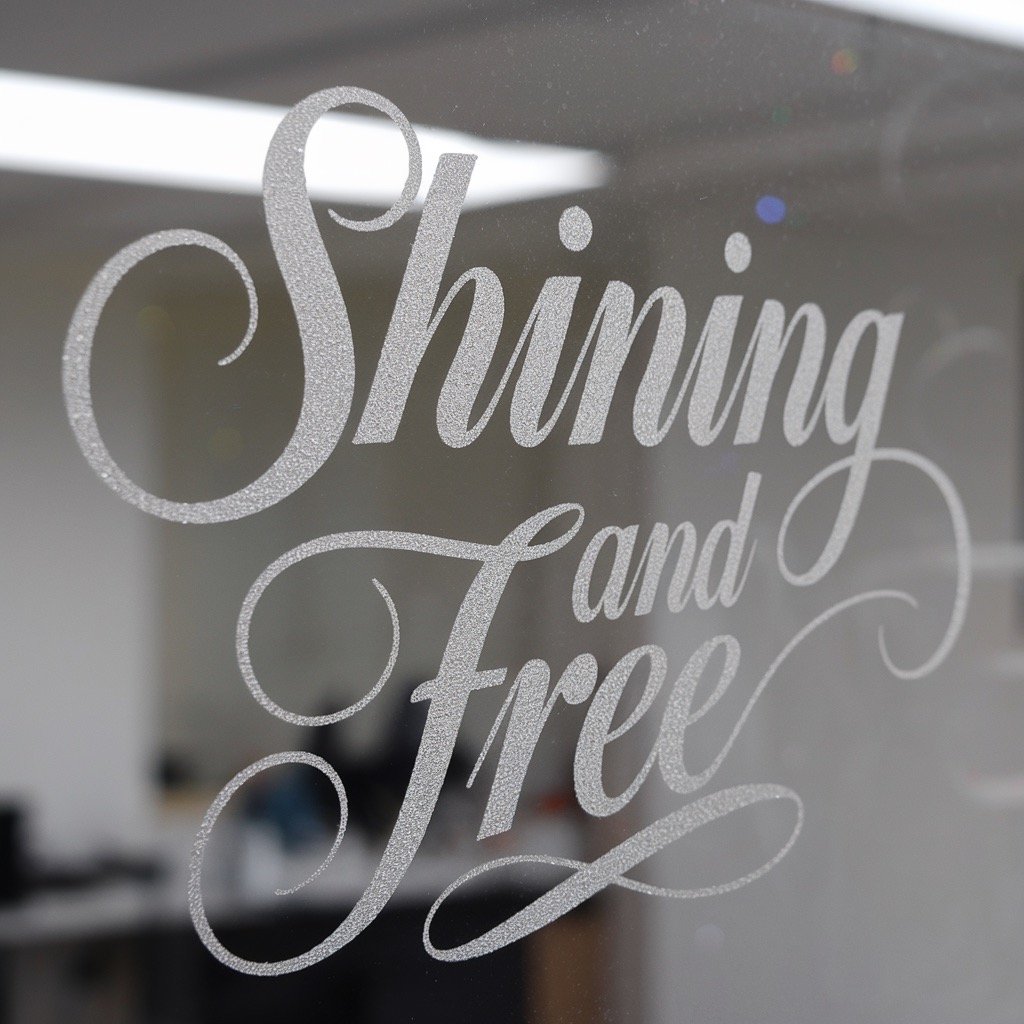Mastering Glass Etching: Your Go-To Guide for Stunning Glass Signs
Introduction
Glass signs are a timeless way to showcase logos, names, and messages with a touch of elegance. They offer a sophisticated appearance that can elevate any space, from corporate offices to cozy homes. One of the most effective ways to enhance these glass signs is through etching. This technique gives a permanent, refined finish, allowing for everything from simple logos to intricate designs. In this guide, we’ll delve into the various glass etching methods, walk you through the process step-by-step, and share tips to ensure your glass signs come out flawless.
Understanding Glass Etching
Glass etching is a method of creating patterns, designs, or textures on the surface of glass by removing a thin layer from the material. There are several techniques to achieve this, each producing unique results. The most popular methods include chemical etching, abrasive etching (sandblasting), and laser etching.
The Allure of Etched Glass Signs
Etched glass signs are favored for their aesthetic charm, durability, and adaptability. Whether in a corporate setting, a stylish restaurant, or a chic home, the frosted or engraved appearance created by etching exudes a level of sophistication that other signage materials can’t match.
Choosing the Right Glass for Etching
Not all types of glass are suitable for etching. Generally, clear, frosted, or tinted glass works best. While tempered glass can also be etched, it requires special care due to its tendency to shatter under stress.
Different Etching Techniques
Chemical Etching
Chemical etching is one of the simplest and most cost-effective ways to etch glass, making it ideal for DIY enthusiasts. This method involves using an acid-based cream to erode the glass surface.
Materials Needed:
Etching cream (like hydrofluoric acid or a safer alternative)
Stencils or masking tape
Gloves and safety glasses
Brushes or applicators
Steps:
Clean the glass thoroughly to remove any dirt or oil.
Apply the stencil to the glass in the desired pattern.
Use a brush to apply the etching cream evenly over the exposed areas.
Let the cream sit as per the manufacturer’s instructions (typically 5-15 minutes).
Rinse off the cream with cold water and remove the stencil.
Advantages:
Simple and quick.
Ideal for small projects and detailed designs.
Disadvantages:
Limited to surface etching.
Requires careful handling of chemicals.
Abrasive Etching (Sandblasting)
Abrasive etching, also known as sandblasting, involves blasting the glass with high-pressure abrasive materials like sand or aluminum oxide to create a frosted effect.
Materials Needed:
Sandblasting unit
Abrasive material (sand, aluminum oxide, etc.)
Protective gear (goggles, mask, gloves)
Stencils or masking film
Steps:
Clean the glass thoroughly.
Apply a stencil or masking film to the glass.
Load the sandblasting unit with abrasive material.
Use the sandblaster to etch the exposed glass areas.
Remove the stencil and clean the glass.
Advantages:
Allows for deep etching and varied textures.
Suitable for large projects and commercial applications.
Disadvantages:
Requires specialized equipment.
Can be messy and needs a controlled environment.
Laser Etching
Laser etching uses a laser beam to precisely remove material from the glass surface, making it perfect for detailed and intricate designs.
Materials Needed:
Laser etching machine
Computer with design software
Protective eyewear
Steps:
Clean the glass thoroughly.
Create the design using software and load it into the laser etching machine.
Place the glass in the machine and start the etching process.
Inspect the glass and clean any residue after etching.
Advantages:
Highly precise and capable of detailed designs.
No physical contact, minimizing the risk of damage.
Disadvantages:
High initial cost of equipment.
Limited to surface etching.
Preparing for Etching
Proper preparation is essential for achieving the best results in glass etching.
Selecting the Right Glass
Choose glass that is smooth, free of imperfections, and appropriately sized for your project. The thickness of the glass should also be considered, depending on the sign’s intended use.
Designing Your Etching Pattern
Whether using a stencil for chemical or abrasive etching or a digital design for laser etching, ensure your design is clear and well-defined. Simpler designs are easier for beginners, while more complex designs may require advanced techniques.
Safety Precautions
Safety is crucial when etching glass. Always wear protective gear, work in a well-ventilated area, and follow the manufacturer’s instructions when handling chemicals or operating equipment.
Step-by-Step Guide to Etching a Glass Sign
Here’s a detailed guide to creating a glass sign using the chemical etching technique.
Materials and Tools
Glass pane
Etching cream
Stencil or masking tape
Brushes
Safety gear (gloves, goggles)
Cleaning supplies (glass cleaner, lint-free cloth)
Setting Up Your Workspace
Choose a well-ventilated, well-lit area for your work. Protect your workspace with newspaper or a drop cloth to catch any spills.
Cleaning the Glass
Clean the glass with a glass cleaner and a lint-free cloth. Ensure the glass is free from dirt, dust, or grease, as these can affect the quality of the etching.
Applying the Stencil
Position the stencil on the glass, ensuring it’s aligned correctly. Press down firmly to remove any air bubbles, which can lead to uneven etching.
Applying the Etching Cream
Using a brush, apply the etching cream generously over the exposed glass. Make sure the cream fully covers the areas to be etched. Avoid skin contact with the cream as it can cause burns.
Timing the Etching Process
Leave the etching cream on the glass for the recommended time. The depth of the etching increases the longer the cream stays on, but be sure not to exceed the manufacturer’s guidelines.
Rinsing and Finishing
After the etching time is up, rinse the glass under cold water to remove the cream. Peel off the stencil and dry the glass with a clean, lint-free cloth.
Inspecting the Finished Product
Check the glass to ensure the etching is even and the design is clear. If any areas are too light or incomplete, you can reapply the stencil and etching cream.
Advanced Etching Techniques
Once you’ve mastered the basics, you can explore more advanced etching methods.
Multi-Layer Etching
This technique involves etching at different depths to create a 3D effect. It requires precision and planning but can produce stunning results.
Combining Etching with Painting
Combine etching with painting for colorful, textured designs. After etching, apply glass-specific paint to the etched areas for a vibrant finish.
Deep Carving
Deep carving involves removing significant portions of the glass to create a sculpted look. This technique is often used in high-end signage and requires professional-grade equipment.
Maintaining Etched Glass Signs
To ensure your etched glass signs maintain their beauty and longevity, regular maintenance is key.
Cleaning Tips
Use a non-abrasive glass cleaner and a soft cloth to clean the glass. Avoid harsh chemicals or abrasive sponges, as these can damage the etched surface.
Protecting the Etched Surface
Consider applying a glass sealant to protect the etched design, especially for outdoor signs exposed to the elements.
Troubleshooting Common Issues
Even with careful work, issues can arise. Here’s how to tackle some common problems.
Uneven Etching
Uneven etching may result from improper application of the cream or abrasive material. To fix this, reapply the stencil and repeat the etching process, ensuring even coverage.
Stencil Bleeding
Stencil bleeding occurs when etching cream seeps under the stencil, causing blurry edges. To prevent this, ensure the stencil is firmly pressed down and use high-quality stencil material.
Glass Damage
If the glass cracks or chips during etching, it might be due to excessive force (in sandblasting) or flaws in the glass. Always inspect the glass beforehand and handle it with care.
Creative Ideas for Glass Signs
Etched glass signs offer endless possibilities for creativity. Here are a few ideas to inspire your next project:
Custom Business Logos
Use laser or abrasive etching techniques to create a sleek logo sign for your office or storefront.
Personalized Home Décor
Design and etch custom glass signs for your home, like nameplates, address signs, or decorative panels.
Event Signage
For weddings, parties, or corporate events, etched glass signs add a sophisticated touch. Consider etching table numbers, welcome signs, or directional signage.
Gifts and Keepsakes
Etched glass makes for unique and personalized gifts. Consider etching names, dates, or special messages onto glass frames, ornaments, or plaques.
FAQs about Glass Etching
What is the safest method for beginners?
Chemical etching is the safest and easiest method for beginners. It requires minimal equipment and is less likely to damage the glass compared to sandblasting or laser etching.
Can I etch glass at home?
Yes, with the right materials and safety precautions, glass etching can be done at home. Make sure to work in a well-ventilated area and wear protective gear.
How long does it take to etch glass?
The actual etching process can take 5-15 minutes, depending on the method. However, including preparation, cleanup, and drying time, the overall process may take a few hours.
Can etched glass be colored?
Yes, you can color etched glass using glass-specific paints or by combining etching with other decorative techniques.
Is etched glass permanent?
Yes, glass etching is permanent. The etched design cannot be removed, so ensure your design is correct before starting.
Can I use any type of glass for etching?
Not all types of glass are suitable for etching. Clear, frosted, and tinted glass are commonly used. Avoid thin or flawed glass, as it may crack or break during the process.
Conclusion
Glass etching is a beautiful and versatile technique for creating elegant glass signs. Whether you're a beginner embarking on a DIY project or a professional honing your craft, understanding the various etching methods, tools, and techniques is essential. By following this guide, you'll be well on your way to mastering the art of glass etching and creating stunning, personalized glass signs that stand the test of time.

